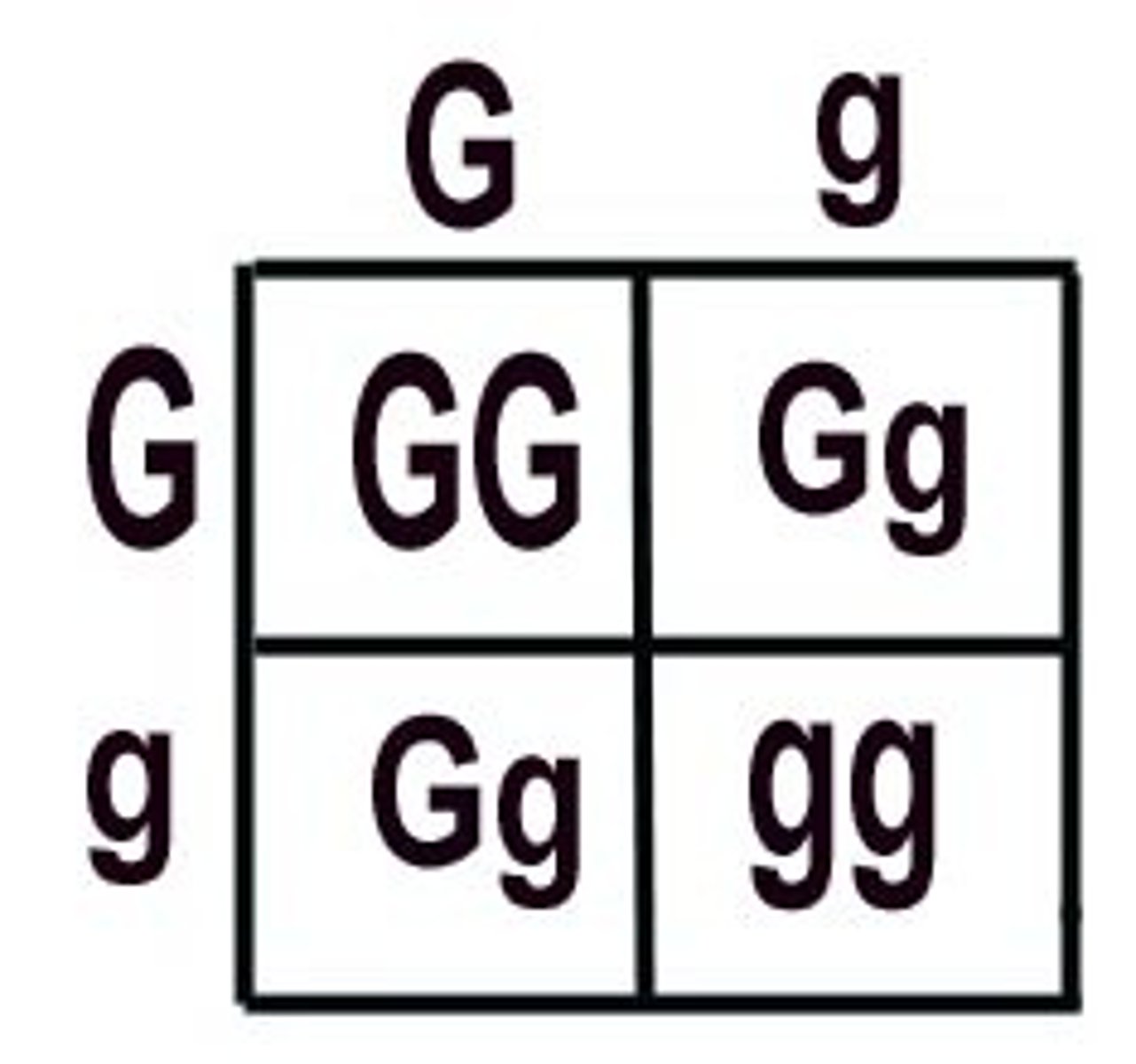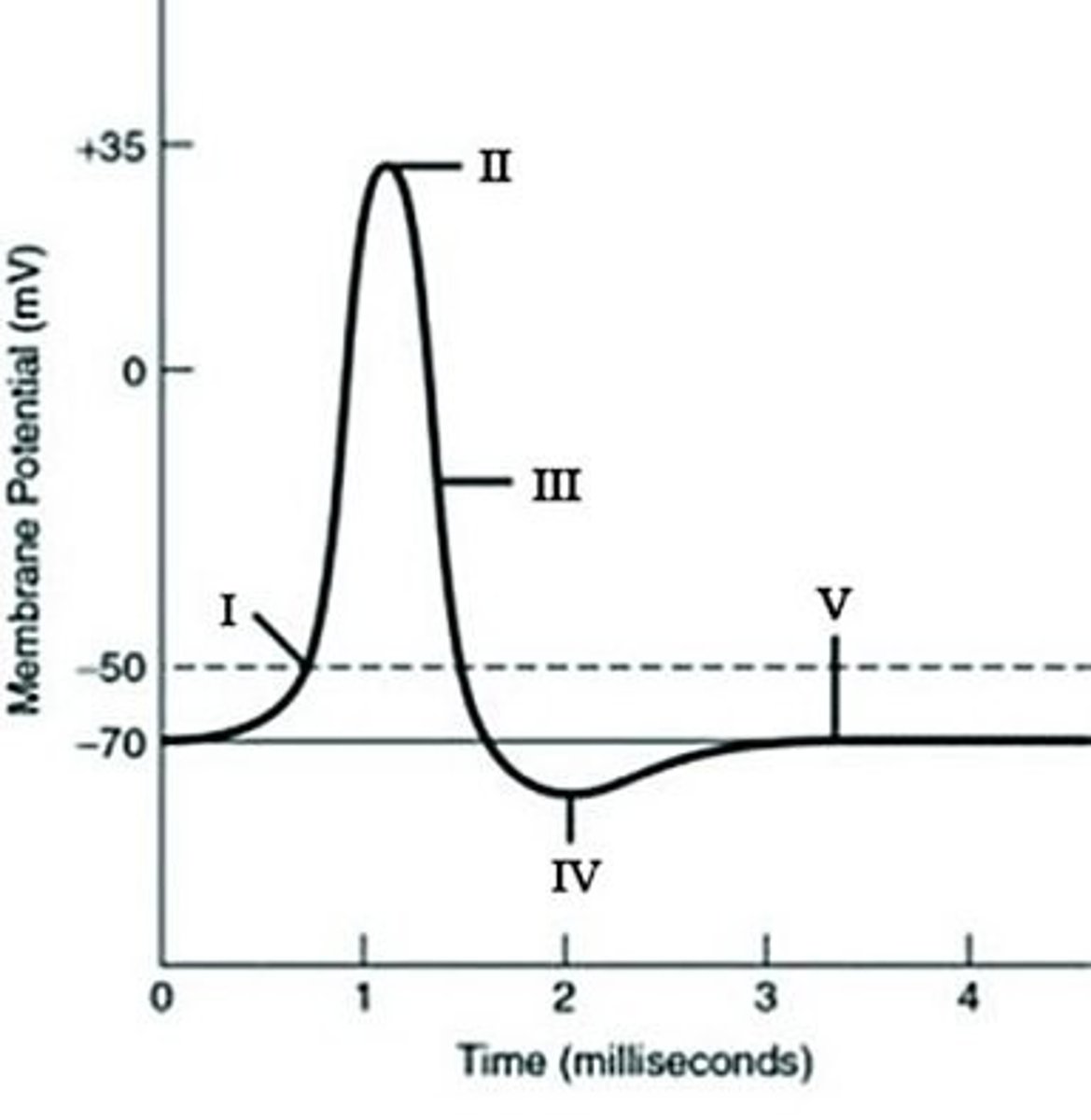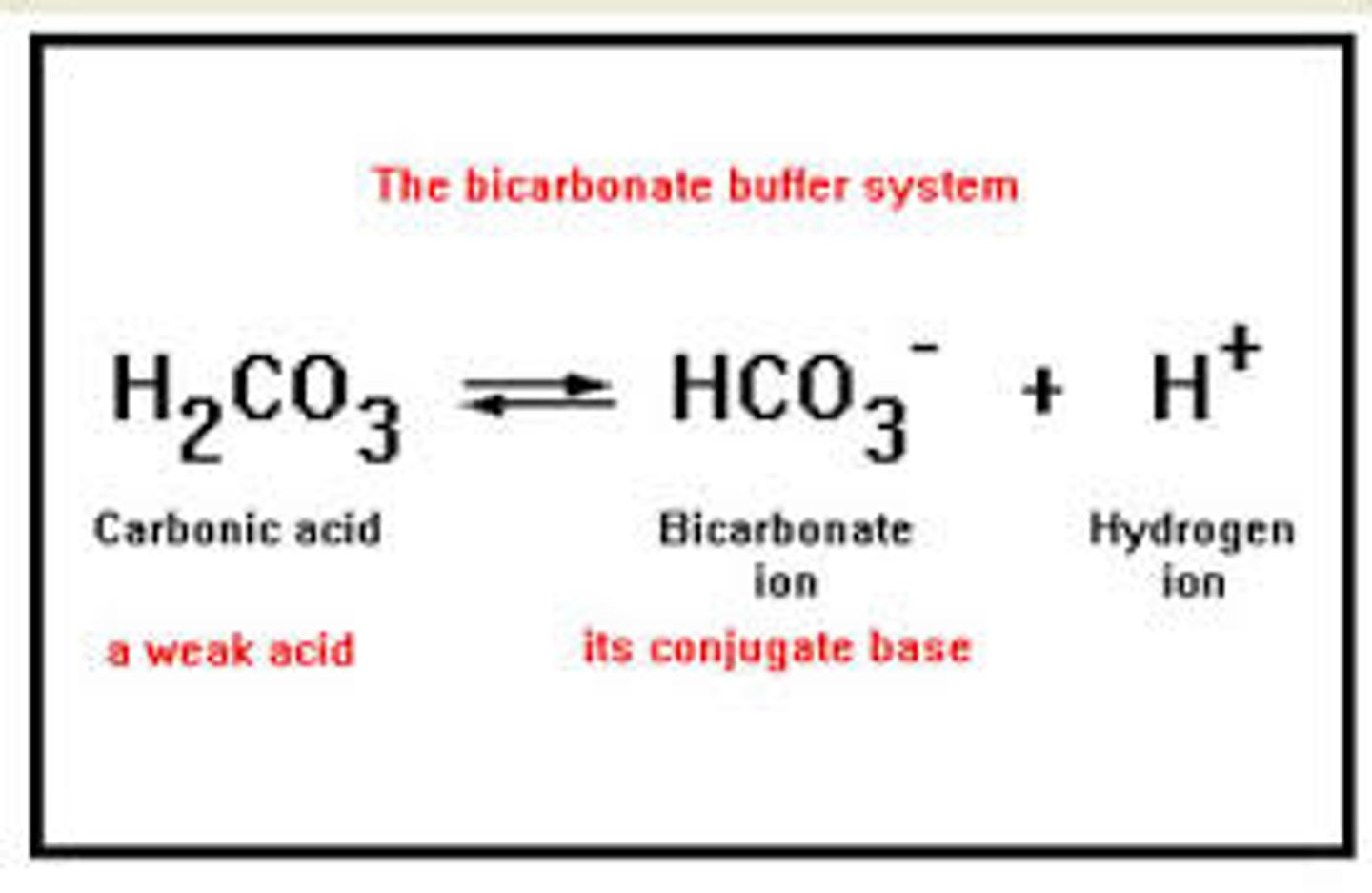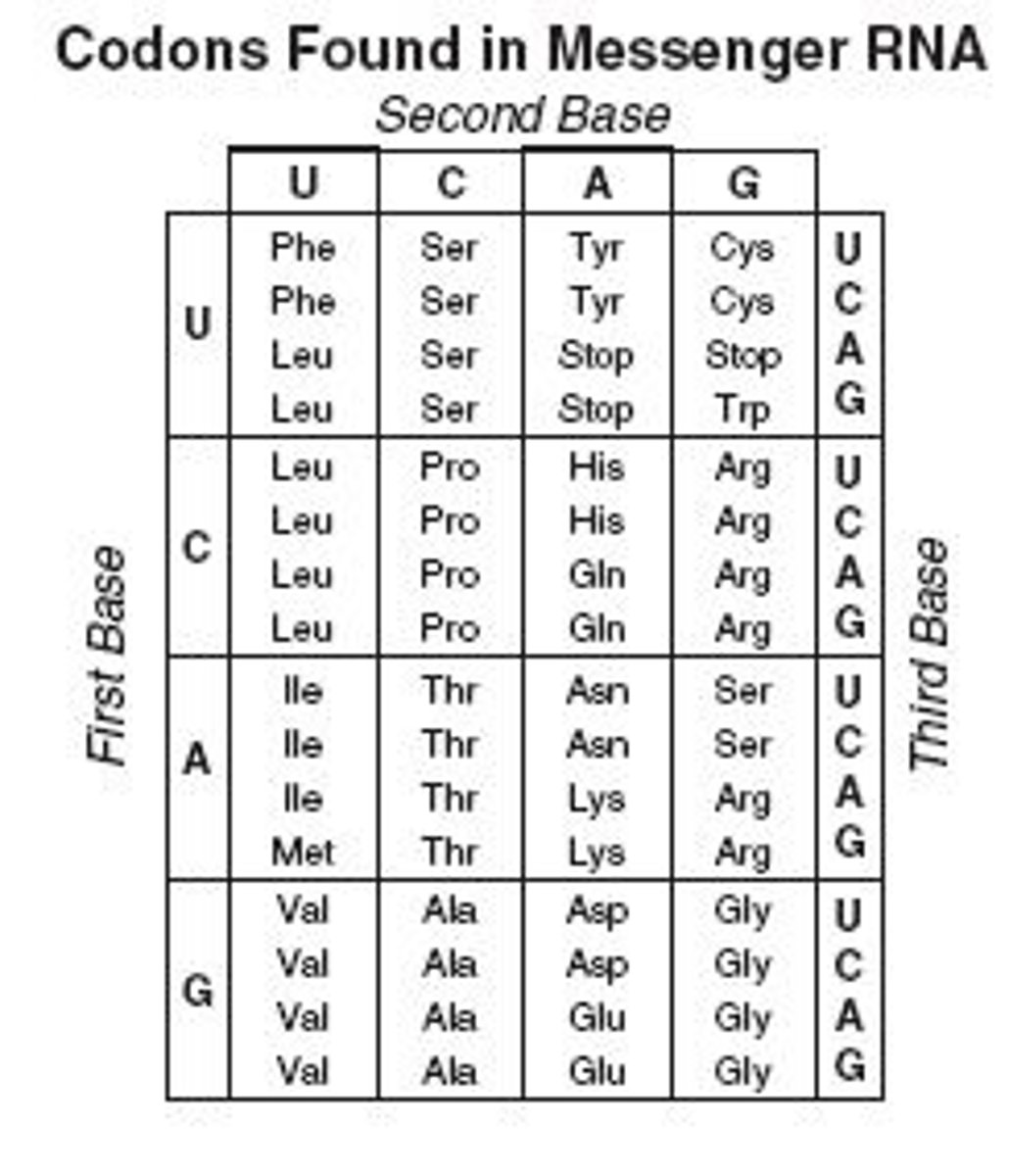Bio93 Final Practice Part 1 & 2
1/37
There's no tags or description
Looks like no tags are added yet.
Name | Mastery | Learn | Test | Matching | Spaced |
|---|
No study sessions yet.
38 Terms
Mendel continued his experiment into the F2 generation in order to ?
observed whether or not a recessive trait would reappear
Use the figure and the following description to answer the question.
In a particular plant, leaf color is controlled by gene locus D. Plants with at least one allele D have dark green leaves, and plants with the homozygous recessive dd genotype have light green leaves. A true-breeding, dark-leaved plant is crossed with a light-leaved one, and the F1 offspring is allowed to self-pollinate. The predicted outcome of the F2 is diagrammed in the Punnett square shown in the figure, where 1, 2, 3, and 4 represent the genotypes corresponding to each box within the square.
Which of the boxes marked 1-4 correspond to plants that will be true-breeding?
1 and 4 only

In pea plants, the tall phenotype is dominant to the dwarf phenotype. If a heterozygous pea plant is crossed with a homozygous tall pea plant, what is the probability that the offspring will be dwarf in size?
0
Suppose two individuals with the genotype AaBbCc are mated. Assuming that the genes are not linked, what fraction of the offspring are expected to be homozygous recessive for the three traits?
1/64
Polydactyly is an inherited disease caused by a dominant autosomal (not on a sex chromosome) allele that results in extra digits (fingers/toes). If a woman with a normal digit number and a man who is heterozygous have a child, what is the probability that the child will have an extra digit?
1/2
True or False: Genetically identical twins must have identical epigenomes
False
Which of the following statements correctly describes the meaning of the chromosome theory of inheritance as expressed in the early 20th century?
Mendelian genes are at specific loci on the chromosome and in turn, segregate during meiosis
Red-green color blindness is a X-linked recessive trait in humans. Two people with normal color vision have a color-blind son. What are the genotypes of the parents?
XNXn and XNY
Which of the following statements would explain a testcross involving F1 dihybrid flies in which more parental-type offspring than recombinant-type offspring are produced?
the two genes are closely linked on the same chromosome
Look at the following figure. Which gene would not be expressed in any of the cells?
PSEN1
Dr. Dre is conducting an experiment where he exposed a culture of cells to irradiation in order to cause mutations in random genes. He manages to cause several missense mutations in a gene coding for histone proteins. As a result, several of the lysine residues that normally reside in the histone tail are replaced with glycine residues. What would you predict is the most likely consequence of this?
all DNA in the nucleus would be loosely packed, and more transcription would be likely
Which of the following mechanisms is commonly used to coordinate the expression of multiple, related genes in eukaryotic cells?
groups of genes that are expressed together have specific combinations of control elements
Dr. Dre is having fun causing mutations in various cell lines in the lab and wants to branch out into genetic engineering. He wants to create a super bacterium and modifies the genome of a bacteria so that its mRNA molecules behave more like eukaryotic cells, and now contain a cap and tail. Surprisingly, he finds that when he exposes his new bacteria to different environmental conditions, they die much faster than his unmodified bacteria. Why do you think this may be?
the cap and tail have extended the half lives of the mRNA molecules and this prevents rapid changes in proteins needed for environmental adaption
In wildtype Drosophila embryos, the bicoid mRNA is localized to the anterior end of the embryo. If bicoid mRNA was injected into the embryo's posterior end as well, which of the following developmental events would occur?
The embryo would show anterior structures at both ends of the embryo
Dr. Dre has become interested in cell differentiation and has heard about the muscle master regulatory gene MyoD. He wonders if he could convert other cell types into muscle cells by introducing the MyoD protein. He finds that introducing the MyoD protein into a fat cell causes that cell to become a muscle cell but adding it to a neuron has no effect. Why might this be?
Muscle-specific gene expression requires a protein that neurons do not make
Which of the following options describes the correct outer-to-inner sequence of tissue layers in a post-gastrulation vertebrate embryo?
ectoderm --> mesoderm --> endoderm
Dr. Dre has progressed from studying cells in culture, to the development of embryos. He has discovered an interesting compound - this new one blocks the process of organogenesis. What effect would he most likely observe if he treated a developing embryo with this compound:
the embryonic germ layers would fail to develop into organs
Dr. Dre has progressed to studying neurons. He applies a potassium leak channel inhibitor to a culture of neurons. What would be one effect of inhibiting these channels?
the resting membrane potential would become more postively charged
Refer to the following graph of an action potential to answer the question.
Which Roman numeral in the graph indicates when the neuronal membrane is at its resting potential?
V

Which of the following will induce a graded hyperpolarization of a membrane under normal resting conditions?
increasing its permeability to K+
Which of the following correctly matches a type of glial cell to one of its functions?
astrocytes- participates in the formation of the blood brain barrier
Dr. Dre is investigating reflexes in two different animals: a crab and a fish. Action potentials are found to pass more rapidly along the fish's neurons. What is a likely explanation?
the fish's axons are myelinated. the crab's axons are not myelinated
The following are events in the transmission of a signal at a chemical synapse.
Neurotransmitter binds with receptors associated with the postsynaptic membrane.
Calcium ions rush into neuron's cytoplasm.
An action potential depolarizes the membrane of the presynaptic axon terminal.
The ligand-gated ion channels open.
The synaptic vesicles release neurotransmitter into the synaptic cleft.
3, 2, 5, 1, 4
Which of the following explains why one-way synaptic transmission occurs?
receptors for neurotransmitters are mostly found on the postsynaptic membrane
What would most likely happen if twice as many inhibitory postsynaptic potentials (IPSPs) as excitatory postsynaptic potentials (EPSPs) arrive in close proximity at a postsynaptic neuron?
no action potential
Stem cell transplants may someday be used to treat Parkinson's disease. How could stem cell transplants alleviate the symptoms of Parkinson's disease?
by secreting the neurotransmitter dopamine
During the biosynthesis of ribosomes, ribosomal proteins synthesized in the [ ] and rRNA molecules are assembled together into ribosomal subunits in the nuclear pores . The subunits are then shipped to the cytoplasm where mature ribosomes are assembled. Bound ribosomes will be localized in the external membrane of the [ ]. Bound ribosomes synthesize [. ], which will be transported to the Golgi apparatus for further processing. The golgi apparatus is also an important site for the synthesis of [. ]
1. cytoplasm
2. Nucleolus
3. rough endoplasmic reticulum
4. integral membrane proteins
5. polysaccharides
A solution of pH 2 will contain a large concentration of OH- ions. Buffers are substances that keep the pH of a solution stable. In blood, the main buffer system is carbonic acid-bicarbonate in which carbonic acid acts as the H+ acceptor .
Looking at the above equation we can deduct that if a basic solution is injected in the blood of a person, the above equilibrium will move to the [. ] The action of buffers in the blood is important to keep the pH stable around [. ]. in the cell, the acidic pH in the lumen of lysosomes is maintained by the action of [. ]
1. H+
2. H+ donor
3. right
4. 7.4
5. co-transporter

1. Chemical reactions that convert solar energy into chemical energy
2. Sequence of carrier molecules that shuttle electrons down a series of redox reactions in mitochondria
3. Transporter of electrons produced during light reactions
4. The second major stage in cellular respiration where acetyl CoA is oxidized to CO2
5. A series of reactions that fixes atmospheric CO2 into carbohydrate
6. A spontaneous chemical reaction in which there is a net release of energy
1. Light reactions
2. electron transport chain
3. NADPH
4. Tricarboxylic Acid Cycle
5. Calvin cycle
6. exergonic
1. Sickle cell anemia
2. Tay-Sachs Disease
3. Familial Hypercholesterolemia
4. Cancer
5. Progeria
1. Hemoglobin subunit
2. lysosomal enzyme
3. LDL receptor mutation
4.Tyrosine Kinase receptor
5. Lamin
A man who is a dwarf with achondroplasia and normal vision marries a color-blind woman of normal height. The man's father was average height, and both the woman's parents were of average height.
A) Dwarfism caused by achondroplasia is autosomal dominant, which means the dominant allele is actually recessive .
B) Red-green color blindness is X-linked recessive, which means that in female offspring, the gene must have both recessive alleles to be expressed in the phenotype .
C) What proportion of their sons would be color blind and of normal height? half .
D) What proportion of their daughters would be color blind and of normal height? one out of four .
1. gene is carried on a non sex-chromosome
2. gene must have both recessive alleles to be expressed in the phenotype
3. half
none
In lecture we discussed some inheritance patterns that are more complex than predicted by simple Mendelian genetics. When we say 'simple Mendelian genetics', this usually refers to [. ] Human traits that follow Mendelian genetics can be tracked using quantitative analysis .
In contrast, the types of patterns we discussed that are more complex than simple Mendelian genetics included [. ], which refers to when one gene affects more than one phenotypic character; and also situations where multiple genes contribute to a specific phenotype, which is called pleiotropy.
1. one character being dependent on one gene, and there is a dominant allele and a recessive allele
2. pedigree analysis
3. pleiotropy
4. polygenic inheritance
1.A covalent bond between atoms that differ in electronegativity
2.The attraction of a given atom for the electrons
3.Having no attraction to water
4. The covalent bond between the carboxyl group on one amino acid and the amino group on another
5. A mechanism by which two molecules become covalently bonded to each other with the removal of a water molecule
6. A coiled region constituting one form of the secondary structure of proteins
1. polar
2. electronegativity
3. hydrophobic
4. peptide bond
5. dehydration reaction
6. alpha- helix
In order for a protein to fold correctly, there are several orders of structure that we discussed in lecture. For example, the secondary structure of a peptide requires [. ] in order to form correctly. If one had a Cdk protein, and there was a mutation or alteration in the primary sequence that affected the secondary structure, then that Cdk might not be able to interact with its partner called a [. ] Or if that mutation was in the kinase domain of the protein, then the Cdk may not be able to carry out its enzymatic function, which involves the [. ] of substrate proteins. In the cell cycle, if a Cdk is unable to perform its job, that would likely trigger a [. ] which would stop the cell cycle until things could be repaired. If one was able to sequence the DNA of the Cdk gene and find out what mutation it had, it is possible to correct that mutation by using [. ] o edit the DNA sequence and make it normal again. This technology has been applied in humans to a disease called sickle cell anemia, which is a good example of when one gene affects more than one phenotypic character, also known as [ ]
1. hydrogen bonds
2. cyclin
3. phosphorylation
4. checkpoint
5. CRISPR
6. heterozygosity
Consider the following DNA sequence in the coding strand:
5`-TTGATGTACAGTATGGCCTATTGAGTAGTTT-3`
Put the following mutations in the order that would be predicted to be the most harmful. (1= Most harmful, 3=Least harmful)
A) 5`-TTGATGTACAGGATGGCCTATTGAGTAGTTT-3`
B) 5`-TTGATGTATAGTATGGCCTATTGAGTAGTTT-3`
C) 5`-TTGATGTAAAGTATGGCCTATTGAGTAGTTT-3`
A. 2
B. 3
C. 1

Mad scientist/rapper Dr. Dre has synthesized 4 compounds, but he is not quite sure what they do. He suspects that they modulate various aspects of gene expression, so he conducts an experiment where he treats a culture of cells with each compound. He monitors the effects of the compounds on the expression of the Bio93 gene. Looking at his results he concludes that Compound A is most likely inhibiting transcription of the Bio93 gene, while Compound [ ] prevents the export of mRNA from the nucleus. Further examination suggests that Compound [. ] is likely inhibiting the splicing of the Bio93 gene, and Compound [. ] seems to be stimulating rapid breakdown of Bio93 mRNA.
1. D
2. A
3. C
4. B
1. Removes RNA nucleotides from the primer from 5` end and then replaces then with DNA nucleotides
2. Synthesizes new strand of DNA by adding new nucleotides to an existing 3` end
3. Breaks apart the hydrogen bonds that hold two strands of DNA together
4. Joins sugar phosphate backbones of 2 adjacent DNA molecules
5. Breaks the sugar phosphate backbone of one strand of DNA, swivels around, and then rejoins the backbone together.
6. Does not require a 3' end to add nucleotides
1. RNA polymerase
2. DNA polymerase 3
3. Helicase
4. DNA ligase
5. Topoisomerase
6. RNA primase
Neurons make many connections with other. [. ] to form circuits in the brain. Neurons signal to other cells using [. ]signaling along their axons, and at its signaling across the synapse. A neuron receives many signals; these signals can be either excitatory or inhibitory, and a neuron has to make sense of all of these signals and determine if it then generates [. ]at its [. ] A neuron determines this based on depolarization events that exceed [. ] which occurs due to spatial and temporal [. ] For example, a neuron conveys the importance of its information in the [. ] of its action potentials. Once an action potential reaches the [. ]it stimulates the release of neurotransmitters through the actions of voltage-gated [. ] channels and [. ]
1. neurons
2. electrical
3. chemical
4. an action potential
5. axon hillock
6. -55 mV
7. summation
8. frequency
9. axon terminal
10. calcium
11. exocytosis